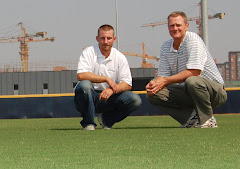So the Chinese turf staff members will be busy at night repairing and replacing the divots. Since each divot will probably be only 2 to 4 inches wide, swapping out a module isn't necessary. (That would be like changing your golf shoes if you lost one spike.) Instead, the technicians will use a tool similar to the hole-cutter used to make a cup or hole in a putting green. The damaged area and 4 to 6 inches of soil will be removed and replaced with a fresh piece of a turf -- a "plug." No surprise to know that this is called "plugging" in turf lingo.
 Trey Rogers (left) and Alec Kowalewski in front of the National Stadium (the Bird's Nest). The turf inside the Bird's Nest is the only field MSU is overseeing.
Trey Rogers (left) and Alec Kowalewski in front of the National Stadium (the Bird's Nest). The turf inside the Bird's Nest is the only field MSU is overseeing. The removal of soil is key, as the turf is damaged, not dead, and the root system transfer is critical. If just the top is removed, there will have to be root regrowth, which is impossible in such a short time. The beauty of the plugging procedure with a modular field is that we can bring in just a few extra modules from outside and take plugs from them, moving the modules we we go.
 The turf modules being moved into National Stadium. To patch divots from the shot put, workers will cut plugs from extra modules.
The turf modules being moved into National Stadium. To patch divots from the shot put, workers will cut plugs from extra modules.I have had people from back home contact me about the Olympic soccer matches they're seeing on TV. They're concerned because they see the turf in varied states and are worried that it's the turf MSU has been overseeing. (I see the games too and worry for the athletes in some cases.) Rest assured, the less than perfect turf you are seeing is not our turf. We are responsible only for one field -- the field in the National Stadium (the Bird's Nest). Grass is grass, and being a living entity, anything can happen over the next two weeks, but the National Stadium turf is our only field and right now it's beautiful.
-- Trey Rogers














